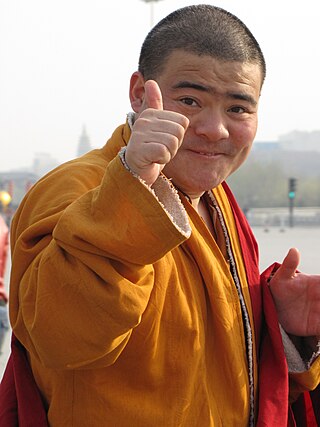Sutton SignWriting, or simply SignWriting, is a system of writing sign languages. It is highly featural and visually iconic, both in the shapes of the characters, which are abstract pictures of the hands, face, and body, and in their spatial arrangement on the page, which does not follow a sequential order like the letters that make up written English words. It was developed in 1974 by Valerie Sutton, a dancer who had, two years earlier, developed DanceWriting. Some newer standardized forms are known as the International Sign Writing Alphabet (ISWA).

In Western culture, "the finger", or the middle finger is an obscene hand gesture. The gesture communicates moderate to extreme contempt, and is roughly equivalent in meaning to "fuck you", "fuck me", "shove it up your ass/arse", "up yours", or "go fuck yourself". It is performed by showing the back of a hand that has only the middle finger extended upwards, though in some locales, the thumb is extended. Extending the finger is considered a symbol of contempt in several cultures, especially in the Western world. Many cultures use similar gestures to display their disrespect, although others use it to express pointing without intentional disrespect. The gesture is usually used to express contempt but can also be used humorously or playfully.

An emoji is a pictogram, logogram, ideogram, or smiley embedded in text and used in electronic messages and web pages. The primary function of emoji is to fill in emotional cues otherwise missing from typed conversation. Emoji exist in various genres, including facial expressions, common objects, places and types of weather, and animals. They are much like emoticons, except emoji are pictures rather than typographic approximations; the term "emoji" in the strict sense refers to such pictures which can be represented as encoded characters, but it is sometimes applied to messaging stickers by extension. Originally meaning pictograph, the word emoji comes from Japanese e + moji; the resemblance to the English words emotion and emoticon is purely coincidental. The ISO 15924 script code for emoji is Zsye.
Wingdings is a series of dingbat fonts that render letters as a variety of symbols. They were originally developed in 1990 by Microsoft by combining glyphs from Lucida Icons, Arrows, and Stars licensed from Charles Bigelow and Kris Holmes. Certain versions of the font's copyright string include attribution to Type Solutions, Inc., the maker of a tool used to hint the font.

The Vulcan salute is a hand gesture popularized by the 1960s television series Star Trek. It consists of a raised hand with the palm forward and the thumb extended, while the fingers are parted between the middle and ring finger.

Maurizio Cattelan is an Italian visual artist. Known primarily for his hyperrealistic sculptures and installations, Cattelan's practice also includes curating and publishing. His satirical approach to art has resulted in him being frequently labelled as a joker or prankster of the art world. Self-taught as an artist, Cattelan has exhibited internationally in museums and Biennials.

Hook 'em Horns is the chant and hand signal of The University of Texas at Austin. Students, alumni, and fans of the university employ a greeting consisting of the phrase "Hook 'em" or "Hook 'em Horns" and also use the phrase as a parting good-bye or as the closing line in a letter or story.

The shaka sign, sometimes known as "hang loose" is a gesture with friendly intent often associated with Hawaii and surf culture. It consists of extending the thumb and smallest finger while holding the three middle fingers curled, and gesturing in salutation while presenting the front or back of the hand; the wrist may be rotated back and forth for emphasis. The shaka sign is similar to the letter Y in the American manual alphabet in American Sign Language. The shaka sign should not be confused with the sign of the horns, where the index and pinky finger are extended and the thumb holds down the middle two fingers.

The OK gesture or OK sign or ring gesture is performed by joining the thumb and index finger in a circle, and holding the other fingers straight or relaxed away from the palm. Commonly used by scuba divers, it signifies "I am OK" or "Are you OK?" when underwater. In most English-speaking countries it denotes approval, agreement, and that all is well or "okay". In other contexts or cultures, similar gestures may have different meanings including those that are negative, offensive, financial, numerical, devotional, political, or purely linguistic.

The sign of the horns is a hand gesture with a variety of meanings and uses in various cultures. It is formed by extending the index and little fingers while holding the middle and ring fingers down with the thumb.

A thumb signal, usually described as a thumbs-up or thumbs-down, is a common hand gesture achieved by a closed fist held with the thumb extended upward or downward, respectively. The thumbs-up gesture is associated with positivity, approval, achievement, satisfaction and solidarity, while the thumbs-down gesture is associated with concern, disapproval, dissatisfaction, rejection and failure.

The hamsa, also known as the hand ofFatima, is a palm-shaped amulet popular throughout North Africa and in the Middle East and commonly used in jewellery and wall hangings. Depicting the open hand, an image recognized and used as a sign of protection in many times throughout history, the hamsa has been traditionally believed to provide defense against the evil eye.
The manicule, ☛, is a typographic mark with the appearance of a hand with its index finger extending in a pointing gesture. Originally used for handwritten marginal notes, it later came to be used in printed works to draw the reader's attention to important text. Though once widespread, it is rarely used today, except as an occasional archaic novelty.
The Hamburg Sign Language Notation System, or HamNoSys, is a transcription system for all sign languages, with a direct correspondence between symbols and gesture aspects, such as hand location, shape and movement. It was developed in 1985 at the University of Hamburg, Germany. As of 2020, it is in its fourth revision.

The ILY is a sign from American Sign Language which, as a gesture, has moved into the mainstream. Seen primarily in the United States and other Americanized countries, the sign originated among deaf schoolchildren using American Sign Language to create a sign from a combination of the signs for the letters I, L, and Y.
Emoticons is a Unicode block containing emoticons or emoji. Most of them are intended as representations of faces, although some of them include hand gestures or non-human characters.

The mini heart gesture is a trend that was popularized in South Korea in which the index finger and thumb come together like a snap to form a tiny heart. The gesture was popularized by K-pop idols, who would often use the gesture to express their love and gratitude to their fans. It is represented in Unicode with the codepoint U+1FAF0🫰 as "Hand with Index Finger and Thumb Crossed".

Che vuoi?, alternatively described as ma che vuoi?, ma che dici?/ma che stai dicendo?, or simply che? ("what?"), is one of the best known hand gestures of Italy. In English, it is sometimes referred to as "pinched fingers" or "finger purse".
As a common symbol throughout typographic history, the heart shape has found its way into many character sets and encodings, including those of Unicode. Some characters depict the shape directly, others reference it in a more derived manner.















